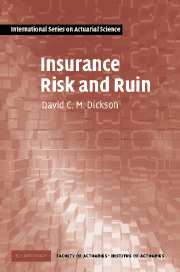Book contents
- Frontmatter
- Contents
- Preface
- 1 Probability distributions and insurance applications
- 2 Utility theory
- 3 Principles of premium calculation
- 4 The collective risk model
- 5 The individual risk model
- 6 Introduction to ruin theory
- 7 Classical ruin theory
- 8 Advanced ruin theory
- 9 Reinsurance
- References
- Solution to exercises
- Index
4 - The collective risk model
Published online by Cambridge University Press: 19 January 2010
- Frontmatter
- Contents
- Preface
- 1 Probability distributions and insurance applications
- 2 Utility theory
- 3 Principles of premium calculation
- 4 The collective risk model
- 5 The individual risk model
- 6 Introduction to ruin theory
- 7 Classical ruin theory
- 8 Advanced ruin theory
- 9 Reinsurance
- References
- Solution to exercises
- Index
Summary
Introduction
In this chapter we consider the aggregate claims arising from a general insurance risk over a short period of time, typically one year. We use the term ‘risk’ to describe a collection of similar policies, although the term could also apply to an individual policy. As indicated in Chapter 1, at the start of a period of insurance cover the insurer does not know how many claims will occur, and, if claims do occur, what the amounts of these claims will be. It is therefore necessary to construct a model that takes account of these two sources of variability. In the following, we consider claims arising over a one-year time interval purely for ease of presentation, but any unit of time can be used.
We start by modelling aggregate claims in Section 4.2 as a random variable, S, and derive expressions for the distribution function and moments of S. We then consider the important special case when the distribution of S is compound Poisson, and we give an important result concerning the sum of independent compound Poisson random variables. In Section 4.4 we consider the effect of reinsurance on aggregate claims, both from the point of view of the insurer and the reinsurer.
The remainder of the chapter is devoted to the important practical question of calculating an aggregate claims distribution. In Section 4.5 we introduce certain classes of counting distribution for the number of claims from a risk.
- Type
- Chapter
- Information
- Insurance Risk and Ruin , pp. 52 - 92Publisher: Cambridge University PressPrint publication year: 2005

